Hey, fellow tone-chaser! Ever felt that your guitar sound is lacking that extra touch of magic or that sonic twist?
We totally get it. Sometimes, you just need that extra layer to make your music soar, pulsate, or just vibe differently. Enter the world of modulation pedals. These beauties can make your guitar sound swirl, shimmer, wobble, and everything in between.
Now, here's our promise: if you're feeling lost in the ocean of pedal choices, we've got the ultimate life raft for you.
We've explored the world of modulation pedals, surfed through the options, and come up with a list that will guide you straight to sonic paradise. And our top pick, the Strymon Mobius Multidimensional Modulation Pedal, will certainly blow your mind.
Stay tuned because we're about to spill the beans on top modulation pedals. From understanding the different types and their unique vibes to choosing the right one for your musical journey, we've got you covered.
Ready to give your sound that sprinkle of magic? Let's dive in together!
Quick Summary of the Best Modulation Pedals
- Strymon Mobius Multidimensional Modulation Pedal (Best Overall Modulation Pedal)
- Meris Polymoon Super-Modulated Delay Pedal (Best Delay)
- Electro-Harmonix C9 Organ Machine Guitar Effect Pedal (Best Organ Effects)
- Electro-Harmonix Memory Toy Analog Delay Pedal with Modulation (Best Classic Analog Delay)
- Meris Enzo Multi-Voice Instrument Synthesizer Pedal (Best Synthesizer Pedal)
- MXR M101 Phase 90 Phaser Pedal (Best Phaser Pedal)
- MXR M152 Micro Flanger (Best Flanger)
- Boss CE-2W Waza Craft Chorus (Best Chorus Pedal)
Best Modulation Pedals
1. Best Overall Modulation Pedal – Strymon Mobius Multidimensional Modulation Pedal
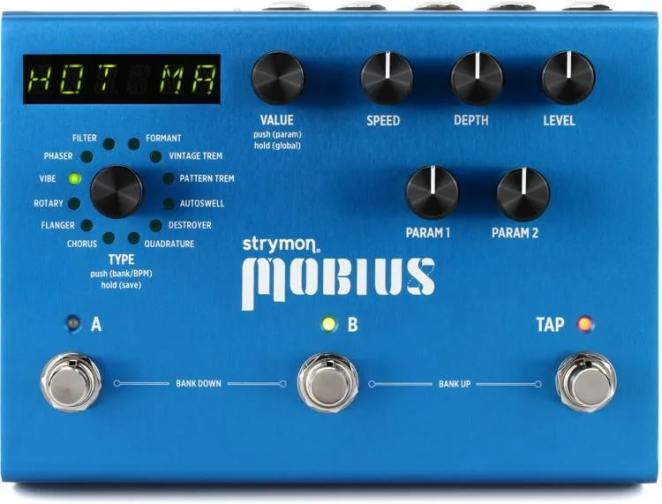
SPECS
- Pedal Type: Modulation
- In/Outs: 2 x 1/4" stereo ins and 2 x 1/4" stereo outs, MIDI, and expression pedal
- Presets: 200
The Strymon Mobius Multidimensional Modulation Pedal is renowned for delivering a diverse array of top-tier modulation effects. With a simple knob rotation, users can access twelve distinct modulation types, coupled with the ability to edit and store their custom settings in 200 onboard presets.
The Mobius boasts a rich range of effects, from mellow tremolo to ethereal flanger sweeps, complemented by chorus, phaser, and rotary, among others. These effects draw inspiration from classic gear but are enhanced to fit modern needs.
While it encapsulates the essence of iconic gear, it offers extensive tone-shaping tools, making it adaptable for any musical scenario. This versatile multi-modulation pedal can potentially replace several other pedals in your setup!
2. Best Delay – Meris Polymoon Super-Modulated Delay Pedal

SPECS
- Pedal Type: Digital Delay
- Effects: Stereo Dynamic Flanger, Stereo Barberpole Phaser, Stereo Modulated Delay: 6 x LFO with Adjustable Waveforms
- Ins/Outs: 1 x 1/4" input and 2 x 1/4" stereo outs
During the 1970s and 1980s, trailblazing guitarists like Allan Holdsworth, Frank Zappa, and Robert Fripp were redefining guitar sounds by fusing several rack units together, creating distinct and novel tones. The Meris Polymoon has distilled this legacy into a more accessible pedal format.
Within its arsenal, it carries a diverse range of modulation effects, such as multi-tap delay, a unique flanger, and a barber-pole phaser. To top it off, it houses modulators with six bespoke LFOs that range from gentle vibratos to dramatic pitch shifts.
What sets the Meris Polymoon apart is its blend of expansive features and user-friendly design. For enthusiasts wanting to delve deeper, it offers a versatile jack for an array of control options, including MIDI connectivity.
By integrating state-of-the-art digital frameworks with high-caliber analog components, Meris stands out in delivering unmatched sound quality in effects pedals.
3. Best Organ Effects – Electro-Harmonix C9 Organ Machine Guitar Effect Pedal
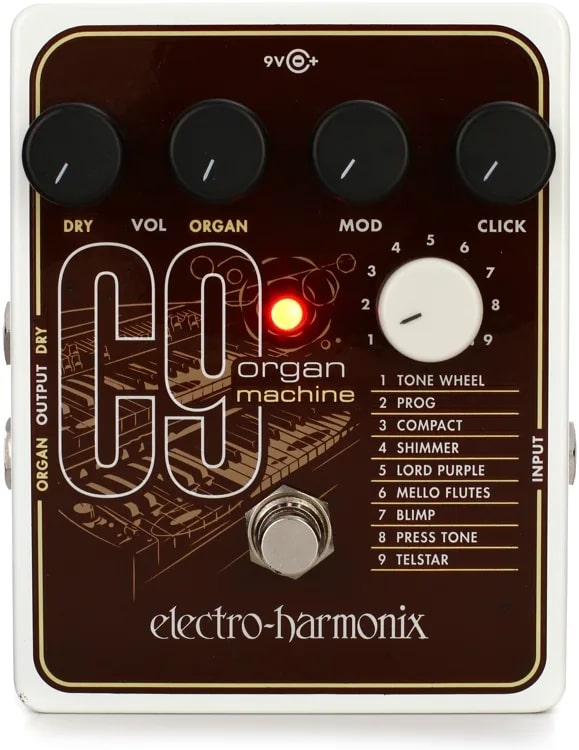
SPECS
- Pedal Type: Organ Emulator
- In/Outs: 1 x 1/4" input and 2 x 1/4" outputs
- Number of Presets: 9
The Electro-Harmonix C9 Organ Machine is the spiritual successor to the famed B9. It's loaded with nine fresh presets that authentically replicate vintage electric organ and keyboard sounds.
Like the B9, the C9 offers user-friendly controls to modify modulation and click elements, amplifying your creative freedom.
With the C9, you're not just getting the typical organ sound; it boasts a vast range of tones from different eras.
The 'Prog' preset thickens tones, the 'Compact' emulates the 60s Farfisa organ, while 'Shimmer' infuses a string resonance. The 'Lord Purple' preset is perfect for a distorted rock feel, 'Mello Flutes' taps into the Mellotron vibe, 'Blimp' captures Led Zeppelin's essence, 'Press Tone' channels the Beatles' Apple Studios organ, and 'Telstar' brings the Clavioline's classic sound to the forefront.
The C9 ensures granular control over various elements like modulation, attack, and sustain, ensuring a sound palette that's as classic as it is unique.
By integrating your raw guitar sound, you can craft tones ranging from vintage to avant-garde. The dual outputs enable intricate setups, perfect for enthusiasts seeking more complex soundscapes.
For those who already have the B9, the C9 isn't just an addition; it's an expansion. Each pedal boasts distinct presets, and when combined, they form a sonic powerhouse.
By utilizing a channel selector, you can create the impression of two separate players or merge the sounds for a sweeping stereo ambiance.
The arrangement possibilities are vast, ensuring every performance is uniquely yours.
4. Best Classic Analog Delay – Electro-Harmonix Memory Toy Analog Delay Pedal with Modulation

SPECS
- Pedal Type: Analog Delay with modulation
- Ins/Outs: 1 x 1/4" input and 1 x 1/4" output
- Presets: None
For guitarists seeking the inspiring sounds of a genuine analog delay without burning a hole in their pockets, the Electro-Harmonix Memory Toy is a dream come true.
Drawing inspiration from the iconic Memory Man, the Memory Toy serves up the same lush analog delay that players adore but at a more accessible price point.
With a single press, you can indulge in up to 550ms of delay time, perfect for enriching solos or diving into the delightful realm of analog ambiance. The pedal also boasts a modulation switch, adding a dash of chorus to its sonic palette, enhancing its versatility.
5. Best Synthesizer Pedal – Meris Enzo Multi-Voice Instrument Synthesizer Pedal
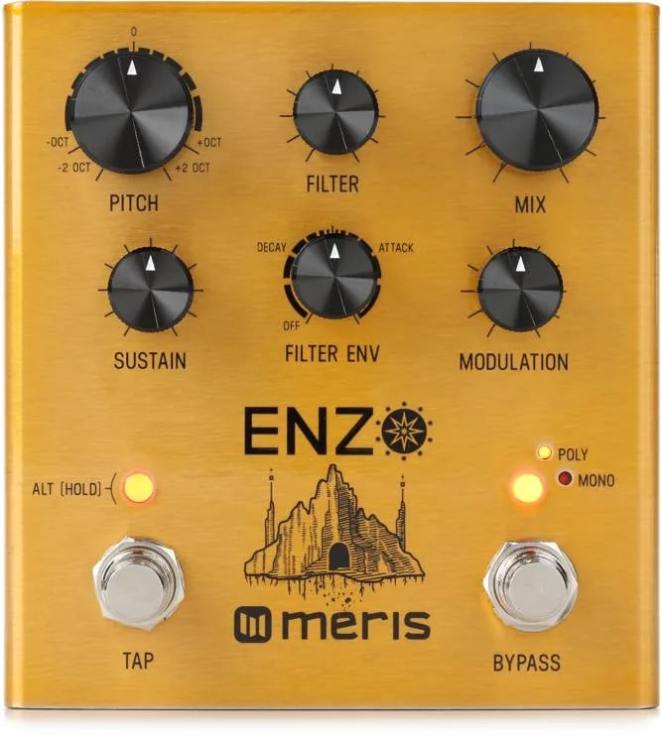
SPECS
- Pedal Type: Synth
- Effects: Multi-voice Dual Oscillator Synth, Two Tap Delay, Filter, Ring Modulation
- Ins/Outs: 1 x 1/4" TRS input and 2 x 1/4" stereo outs
The Meris Enzo multi-voice instrument synthesizer is a powerful tool that morphs your guitar into a versatile synthesizer. For guitarists intrigued by the expansive universe of synthesizers, the Enzo offers a vast spectrum of synth sounds, ranging from raw and gritty to smooth and luminous.
It comes equipped with three distinct synth modes: the monosynth mode, designed for bold bass lines and sharp leads, evokes the essence of classic analog synths. The polysynth mode, on the other hand, is perfect for producing rich chords that resonate with polyphonic synth vibes.
Additionally, the arpeggiated synth mode allows you to craft Tangerine Dream-inspired sequences just by strumming chords.
The pedal further enriches your sonic creativity by incorporating quintessential synth elements like a multimode resonant filter, envelope generators, ring modulation, adjustable portamento, and sustain options.
An added feature is its specialized modulated tap tempo delay, which is perfect for crafting rhythmic echoes or adding a chorus touch to your sound.
6. Best Phaser Pedal – MXR M101 Phase 90 Phaser Pedal
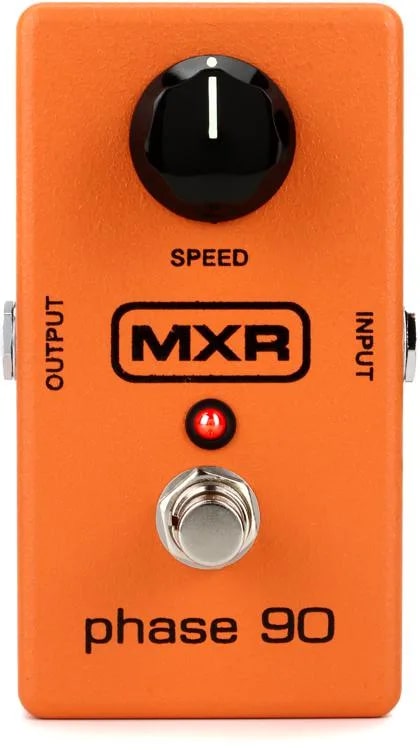
SPECS
- Pedal Type: Phaser
- Ins/Outs: 1 x 1/4" input and 1 x 1/4" output
- Presets: None
The MXR Phase 90 is a renowned phase pedal that has earned its spot in the setups of iconic guitarists ranging from Eddie Van Halen and Dave Grohl to Josh Homme and Nancy Wilson.
Many skilled guitarists have embraced it to introduce a sparkling dimension to their solos or to add a liquid-like texture to their chords and muted strums.
The MXR Phase 90 boasts a simple design, operated by just a single knob, yet it offers a wide range of sonic possibilities. It's compatible with several instruments, from guitars and basses to keyboards and vocals.
This pedal's knob provides users the flexibility to adjust the modulation speed, ranging from a subtle sweep to a faster, wave-like oscillation. Furthermore, for power options, it can run on a battery or be connected to an optional AC adapter, which needs to be purchased separately.
7. Best Flanger – MXR M152 Micro Flanger
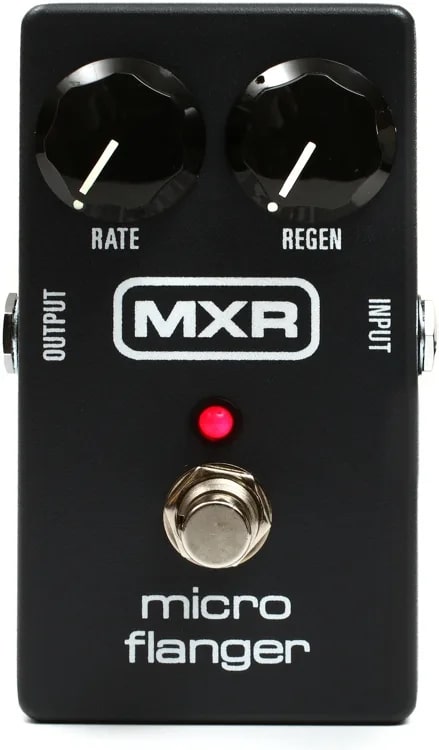
SPECS
- Pedal Type: Flanger
- Ins/Outs: 1 x 1/4" input and 1 x 1/4" output
- Presets: None
The all-analog MXR Micro Flanger offers the legendary sounds of the MXR flanger, reminiscent of the M117 pedal, but packages them in a more compact and pedalboard-friendly format.
Echoing the beloved '80s pedal, the Micro Flanger features two primary controls: Speed and Regeneration, allowing you to craft your ideal sound. Embracing its legacy, it employs 100% analog bucket-brigade technology, ensuring the warm and rich character inherent to analog devices.
Additionally, its true bypass design ensures your original tone remains unaltered when the pedal is disengaged. If you are looking for a classic flanger circuit in a simple pedal, this MXR Micro-Flanger is a great choice!
8. Best Chorus Pedal – Boss CE-2W Waza Craft Chorus
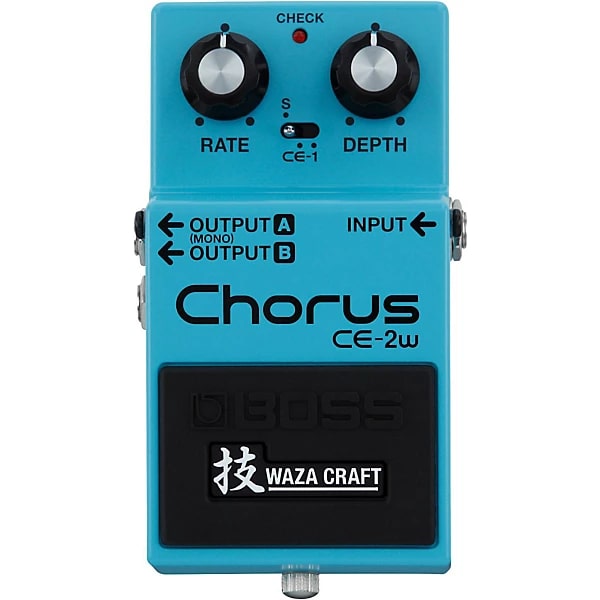
SPECS
- Pedal Type: Chorus, Vibrato
- Ins/Outs: 1 x 1/4" input and 2 x 1/4" mono/stereo outs
The BOSS CE-2W Chorus Waza Craft Special Edition pedal is a modern homage to the iconic CE-1 Chorus Ensemble, BOSS's inaugural pedal, which still holds a revered place among guitarists after four decades.
Utilizing superior all-analog circuitry, the CE-2W faithfully reproduces the signature sound of both the CE-1 and its successor, the CE-2. With a simple switch, users can transition between the characteristic CE-2 sound and the CE-1's chorus and vibrato effects.
Elevating its prowess beyond the original models, the CE-2W offers stereo output for CE-2 tones and adjustable depth for CE-1's chorus nuances, allowing musicians to introduce expansive modulated effects to their sound.
The term "waza," which translates from Japanese to "art and technique," perfectly encapsulates the essence of BOSS's elite line of reimagined guitar effects pedals.
Even in their standard modes, these pedals present as enhanced versions of the original, delivering iconic sounds with reduced noise and greater tonal consistency.
Best Modulation Pedals Buyer's Guide
When shopping for the best modulation pedals, a buyer should consider various factors to ensure that the chosen pedal will serve their musical needs and preferences. Here are the four most important things to consider:
- Type of Modulation Effect
- Sound Quality & Character
- Features & Flexibility
- Build Quality & Budget
Type of Modulation Effect
The type of modulation effect is of paramount importance when shopping for the best modulation pedal. Each modulation type imparts a distinct sound character, affecting the emotional and aesthetic qualities of a piece of music.
For instance, a chorus effect can provide a lush and spacious sound reminiscent of multiple instruments playing together, while a tremolo can introduce rhythmic pulses and dynamics to a piece. Choosing the right type of modulation ensures that the musicians can express themselves as intended.
Certain modulation effects are historically associated with specific genres. For instance, the phaser is often linked with psychedelic rock, the chorus with '80s pop and rock, and tremolo with old-school surf rock. If you aim to capture the authentic sound of a specific genre, the correct modulation effect is crucial.
Different modulation effects can change the way an instrument feels when played. A deep vibrato might cause a guitar to feel more alive and reactive, while an intense flanger could introduce a swirling, almost unpredictable dynamism to the sound. These playability dynamics influence a performer's connection with their instrument.
Musicians often have a pedalboard setup or studio rig where they integrate new gear. Some modulation effects might gel better with existing equipment and desired tones.
For instance, if one already has a delay pedal that provides a certain spatial dimension, a chorus pedal might complement it beautifully by adding depth.
Some modulation pedals are dedicated to delivering one effect to perfection, offering various controls to fine-tune that specific sound. Others provide a range of modulation effects in a single unit but might compromise slightly on the depth of control for each effect.
Knowing the type of modulation effect you desire helps in deciding between a versatile multi-modulation pedal or a specialized single-effect unit.
Sound Quality & Character
The primary function of any musical equipment is to produce sound. If the quality of this sound is compromised, it undermines the pedal's essential purpose.
A modulation pedal should offer a clear, noise-free, and true representation of the intended effect without introducing unwanted coloration or artifacts unless deliberately designed to do so.
Even within the realm of high-quality pedals, each one often has a unique tonal character, which can be subtle or overt. This character influences how the pedal interacts with different instruments, amplifiers, and other pedals.
A modulation pedal with top-notch sound quality and a pleasing character is likely to remain a staple in a musician's setup for a longer time, providing better value for the investment.
Features & Flexibility
Features and flexibility in a modulation pedal are pivotal aspects that can determine its utility, versatility, and overall satisfaction for the user.
Having multiple controls or modes on a pedal means it can be adjusted to suit various musical situations, from intimate acoustic gigs to large arena rock shows.
The ability to fine-tune parameters ensures the pedal can be adapted to different instruments, amplifiers, or other effects in a musician's signal chain.
More features and flexible controls allow musicians to explore a broader sonic palette, fostering creativity. This exploration can lead to unique sounds or innovative approaches to songwriting and performance.
Features like MIDI compatibility, the ability to store presets, or connectivity with software can make a pedal more compatible with evolving technology and modern music production environments.
While paradoxical, more features can sometimes lead to reduced complexity in a setup. For example, a modulation pedal with built-in stereo capability can simplify a stereo rig, removing the need for additional routing or equipment.
Build Quality & Budget
Build quality and budget are two intertwined factors that significantly impact the longevity, functionality, and overall value of all pedals, not just modulation pedals.
Musicians, especially those who perform live, need equipment they can rely on. A pedal with a robust build will resist wear and tear from frequent use, accidental knocks, or the rigors of touring.
Components like sturdy footswitches, durable chassis materials, and high-quality connectors contribute to longevity and consistent performance.
It's often tempting to go for cheaper options, but low-cost pedals might compromise on build quality. In the long run, a slightly pricier but well-built pedal can save money by avoiding frequent replacements or repairs.
Well-constructed pedals, especially those from reputable brands, tend to retain their value better over time. Should you decide to trade or sell, a pedal in good condition will fetch a better price.
Investing wisely at the outset, even if it's a bit more expensive, can ensure better returns if selling or trading becomes necessary.
The tactile experience, such as the feel of the knobs or the response of the footswitch, contributes to the overall satisfaction of using a pedal.
A high-quality build often equates to a better user experience. It's important to find a pedal that feels good to use within your budget range, ensuring you're motivated to engage with it frequently.
The best value doesn't always mean the cheapest or the most expensive. It's about getting a pedal that meets your sound and durability needs at a price you're comfortable with.
Sometimes, saving up a little longer for a pedal that ticks all the boxes in terms of build quality can be more economically wise in the long run.
In essence, while the sonic attributes of a modulation pedal are of paramount importance, the build quality ensures that those sonic attributes can be enjoyed consistently over time.
Pairing this with a well-planned budget ensures that musicians get the maximum value, both in terms of performance and financial investment.
Frequently Asked Questions (FAQs)
What are modulation pedals?
Modulation pedals alter the sound signal to produce effects like chorus, phaser, flanger, and tremolo.
What's the difference between chorus, flange, phaser, and tremolo?
While all are modulation effects, each produces distinct sounds. Chorus thickens and doubles the sound, flanger gives a swooshing jet-like sound, phaser adds a swirling effect, and tremolo modulates the volume of the signal.
Can I use modulation pedals for instruments other than guitar?
Yes, modulation pedals can also be used with bass, keyboards, and even vocals, depending on the pedal.
Is true bypass important in a modulation pedal?
True bypass ensures the pedal doesn't color your tone when turned off. However, some musicians prefer the "buffered bypass" in certain situations to maintain signal strength, especially in long signal chains.
Conclusion
In the realm of guitar effects, modulation pedals stand as pivotal tools, crafting sonic landscapes that range from the subtlest of shimmers to the wildest of warbles.
Whether it's the undulating embrace of a chorus, the swirling depths of a phaser, or the rhythmic pulse of a tremolo, the power of modulation is undeniable.
Throughout this article, we've explored some of the best options available, each with its own unique voice and capability. Our top overall pick, the Strymon Mobius Multidimensional Modulation Pedal, is an insane beast among multi-modulation pedals.
However, the true magic of these pedals is not just in their individual prowess but in how they can be tailored to resonate with a musician's unique expression.
The journey to find the "best" modulation pedal is as much about personal discovery as it is about technical specifications. As technology and innovation march on, we can be sure that the world of modulation will continue to expand, offering even more avenues for creative exploration.
Take your guitar sound to the next level with our best guitar preamp pedals. Explore our collection today!
Interested and looking for acoustic guitar pedals? Take a look at our selection of best acoustic guitar pedals.
Looking for the perfect bass synth pedal? Look no further! Check out our top picks for the best bass synth pedals and find the one that suits your style.
Discover the best expression pedals for ultimate control and expression in your music.
Master your delay effects! Shop now for the best tap tempo delay pedals and craft dynamic musical tones.
